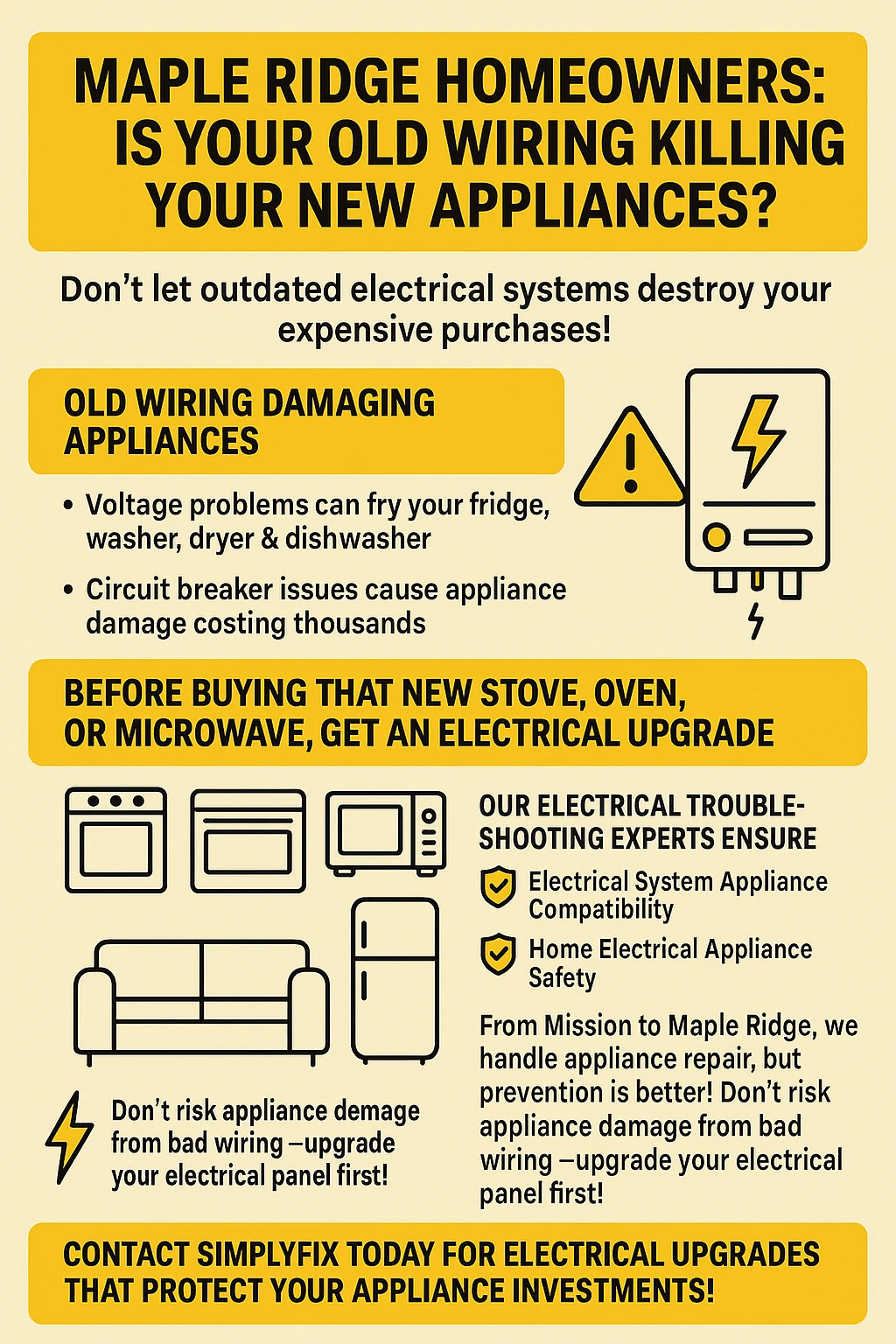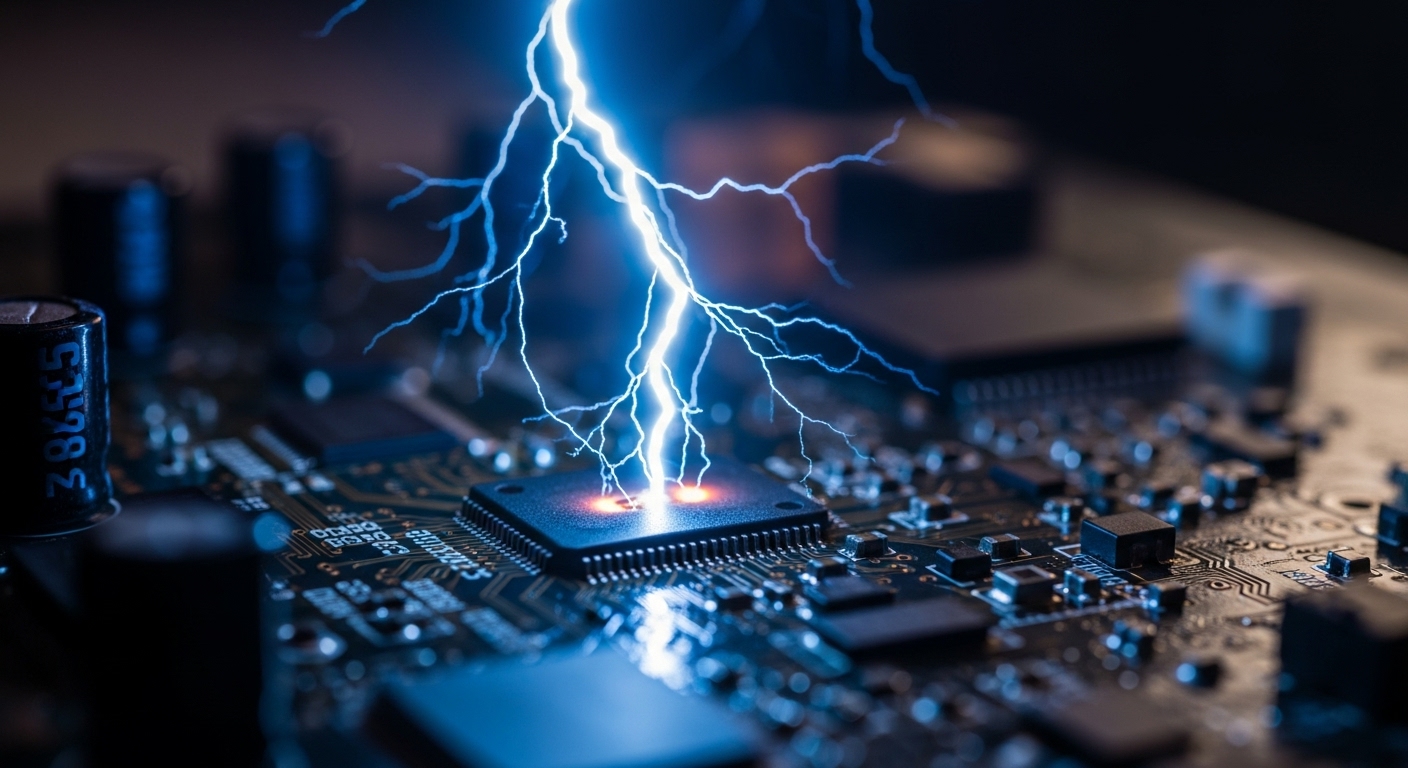Tired of watching your expensive new appliances die mysterious deaths just a few years after purchase? You’re not imagining things – thousands of Maple Ridge homeowners are discovering that their charming older homes hide a silent killer that’s systematically destroying modern appliances worth tens of thousands of dollars.
Picture this scenario that plays out in homes across Maple Ridge every single day: you’ve just invested $4,000 in a gorgeous new smart refrigerator, energy-efficient dishwasher, and high-tech washing machine for your beautiful heritage home. Everything looks perfect until six months later when your fridge starts displaying random error codes, your dishwasher trips the circuit breaker every time you run a full cycle, and your washing machine’s digital display flickers ominously during the spin cycle.  This isn’t just rotten luck or defective products – it’s the harsh reality of trying to run sophisticated 21st-century technology on electrical systems that were designed when most homes had maybe three outlets total.
This isn’t just rotten luck or defective products – it’s the harsh reality of trying to run sophisticated 21st-century technology on electrical systems that were designed when most homes had maybe three outlets total.
The invisible culprit destroying your appliances isn’t some mysterious manufacturing defect or planned obsolescence conspiracy. It’s your home’s aging electrical system working against your modern appliances every single day through power surges, voltage fluctuations, and electrical instabilities that slowly cook sensitive electronic components from the inside out. While you’re going about your daily routine, your electrical system is experiencing approximately 20 power surges daily, with each small voltage spike chipping away at your appliances’ internal circuits like invisible electrical termites eating away at your investment.
Here’s what makes this situation particularly devastating: most homeowners don’t realize the damage is happening until it’s too late to prevent catastrophic appliance failures. Your home’s outdated wiring isn’t just an inconvenience – it’s actively sabotaging every smart appliance, energy-efficient device, and modern convenience you bring into your house. The average Maple Ridge home now contains approximately $15,000 worth of surge-sensitive electronics and appliances, all sitting vulnerable in an electrical environment that was never designed to protect them.
Key Outtakes:
- Maple Ridge homes experience approximately 20 daily power surges that slowly degrade modern appliance electronics, with 60-80% originating from internal sources that pre-1990s electrical systems cannot properly manage
- The average home contains $15,000 worth of surge-sensitive electronics and appliances that are exponentially more vulnerable to electrical fluctuations than traditional mechanical appliances
- Pre-1990s homes typically operate on 60-100 amp electrical service while modern households require 200-amp service, creating chronic overloading conditions that damage appliances daily
- Aluminum wiring common in 1960s-1970s Maple Ridge homes degrades 25-30% faster in the Fraser Valley’s humid climate, accelerating appliance-damaging electrical problems
- Electrical system upgrades costing $3,000-$8,000 prevent $6,000-$12,000 in appliance replacement costs over 15-20 years while increasing home value and safety

The Hidden Crisis: How Outdated Electrical Systems Create Appliance Graveyards

Walking through Maple Ridge’s charming neighborhoods filled with character homes from the 1960s and 1970s, you’d never suspect that behind those beautiful facades lurks an electrical crisis that’s systematically destroying modern appliances. The fundamental problem isn’t immediately obvious – lights turn on, outlets work, and everything seems fine until expensive appliances start failing at alarming rates. The reality is that electrical systems designed for a completely different era are now being forced to support households filled with sophisticated technology they were never designed to handle.
Modern appliances are essentially computers disguised as household equipment, packed with circuit boards, sensors, and electronic controls that require clean, stable electrical power to function properly. Your smart refrigerator monitors temperatures with digital sensors, your washing machine uses computerized controls to optimize water levels and spin cycles, and your dishwasher communicates with multiple electronic components throughout each cleaning cycle. These sophisticated devices operate within precise voltage parameters – typically requiring stable power between 114-126 volts – and they cannot tolerate the electrical fluctuations that older, mechanical appliances could easily handle.
The heart of the problem lies in the massive increase in electrical demands that has occurred over the past 40 years. Homes built in the 1960s and 1970s were designed around electrical panels with 60-100 amp capacity, adequate for households where the biggest electrical loads might have been a hair dryer or window air conditioner. Today’s smart homes routinely require 200-amp service to safely handle simultaneous operation of central air conditioning, electric heating, multiple large appliances, electric vehicle charging, and dozens of electronic devices that define modern living.
When you force modern electrical demands through an undersized, aging electrical system, the result is a perfect storm of appliance-destroying conditions. Chronic overloading creates voltage fluctuations as the system struggles to deliver adequate power to multiple devices simultaneously. Aging wiring develops increased resistance that causes voltage drops, forcing appliance motors to work harder and draw more current. Corroded connections create intermittent arcing that sends damaging electrical spikes throughout your home’s wiring. Each of these problems individually can shorten appliance lifespan, but when they combine in an aging electrical system, they create an environment where even high-quality appliances fail within 5-7 years instead of their expected 10-15 year lifespan.
The situation becomes even more complex when you consider that Maple Ridge’s location in the Fraser Valley creates environmental conditions that specifically accelerate electrical system degradation. The region’s high humidity and persistent moisture promote corrosion of electrical connections, particularly in homes with aluminum wiring that was standard during the 1960s-1970s construction boom. Seasonal temperature swings cause thermal expansion and contraction that progressively loosens connections over time, creating the unstable electrical environment that proves fatal to modern appliances.
Understanding Power Surge Damage: The Silent Appliance Killer

Most homeowners think of power surges as dramatic events involving lightning strikes or obvious electrical faults, but the reality is far more insidious. The power surges that cause the most appliance damage are small, frequent events that you probably don’t even notice happening – yet they’re slowly degrading your appliances’ internal components every single day. Understanding how this process works explains why appliances that seem to be functioning perfectly can suddenly fail without warning, often just after their warranties expire.
Approximately 60-80% of power surges in residential environments originate from internal sources, particularly when large appliances with electric motors cycle on and off throughout the day. Every time your refrigerator compressor kicks on, your air conditioner starts up, your washing machine begins a cycle, or your dishwasher activates, it creates a momentary surge as these devices draw substantial starting current. In a properly designed and maintained electrical system, the panel and wiring are engineered to absorb these internal surges and prevent voltage spikes from affecting other appliances in the home.
However, in homes with inadequate electrical infrastructure – undersized panels, aging wiring, or loose connections – these routine appliance operations create voltage spikes that radiate throughout the electrical system. Each spike is relatively small, perhaps only 5-20 volts above normal, but the cumulative effect over months and years proves devastating to sensitive electronic components. Circuit board traces experience microscopic damage, capacitors accumulate internal stress, and power supply components gradually degrade until they reach the point of failure.
The mathematical reality is sobering: if your home’s electrical system generates 50-100 damaging micro-surges daily due to inadequate infrastructure, an appliance designed to last 10-15 years in optimal conditions may fail within 5-7 years. The failure often appears sudden to homeowners – the appliance simply stops working one day – but the damage process has been accumulating invisibly for years. This explains why multiple appliances from different manufacturers often seem to fail around the same timeframe; they’re all experiencing the same electrical stress from your home’s inadequate infrastructure.
Smart appliances face even greater vulnerability because they contain sophisticated power supply circuits that convert 120-volt household current to the low-voltage DC power needed by digital components. These power supplies can typically handle voltage variations of about 10%, but surges exceeding this range can permanently damage delicate semiconductors and microprocessors. A power surge lasting just microseconds can destroy a $2-$5 power supply module, rendering an entire $2,000 appliance unrepairable. The proliferation of electronics in modern appliances means multiple points of vulnerability exist within each device, increasing the probability that repeated electrical stress will eventually cause failure.
Voltage Drop: The Hidden Performance Killer
While power surges get most of the attention in discussions about electrical damage,


Recent Comments